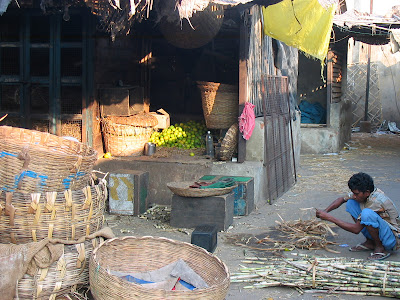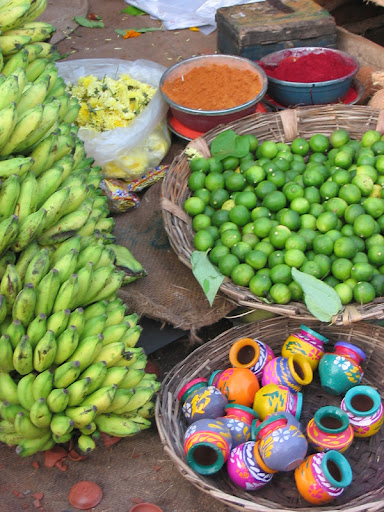Exploring Colorful Indian Bazaars
The colors, sights, and sounds of Indian bazaars are amazing. For those of us not living or visiting India at the moment, Kiran Keswani has created website, Indian Bazaars, that offers a glimpse into an incredible cultural phenomenon, and makes us want to travel there and experience them for ourselves. If we unable to, Kiran lets us see inside a complex culture, and opens it up a bit for us to explore. We were lucky enough to sit down and chat with Kiran about her site Indian Bazaars, the bazaar culture, gving back, and more. Here's what she had to say...
WE: Please tell us about your site, Indian Bazaars...
KK: I have been writing mostly about the simple selling spaces in urban India that people frequent for their day-to-day needs - whether it is vegetables or flowers, clothes or religious items. It is only because these are the bazaars I seemore often.

In a Bazaar, there are undemarcated spaces to display, spaces to work and spaces to store - the Poorna market in Visakhapatnam
WE: What was the genesis of your site?
KK: I think it is the changing nature of the bazaar that has always fascinated me. It all started out as a personal diary. I started to photograph and write about bazaars. Each time I visited a new town or city, I would get to discover yet another bazaar. Every place had its own kind of bazaar environment. As you visit more and more bazaars, you begin to read patterns within them.
WE: India has such a unique bazaar culture - can you please share more of that with us?
KK: There is a simultaneous complexity and commonality embedded within the bazaars. In so many places, there are the colourful flowers entering the market with every break of dawn; the flower vendor spaces are inextricably woven with the vegetable vendor spaces, street corners become either a confluence of both or the receding of one; there is the emergence of an entire streetful of kite makers a month before Sankranti (harvest festival) or the rising crescendo of firecracker sales as Diwali (festival of lights) draws near. Every bazaar is different from another and yet they have similarities in their spatial clustering and in their randomness. The efficiency of the market system from one town or city to another seems to depend often on the same issues. The decline of the bazaar and its replacement by modern shopping spaces shows the same patterns.
The shade of a tree often makes for an 'urban selling space' - a flower vendor at Malleswaram in Bangalore
WE: How can travelers get the most out of visiting Indian Bazaars?
KK: For me, the experience has become more interesting when I have talked to local people about their neighbourhood bazaar or the main market of their city. That way, you see a lot more when you visit it yourself. We have moved to Bangalore only recently and I have started to enjoy my visits to Gandhi Bazaar more after talking to friends who grew up in the Basavanagudi area, who know which house belonged to whom along this street bazaar, which theatre artist lived there, what were the things that you could buy here and nowhere else, the oldest restaurant there and so on. There is so much more that you understand when you talk to people. As a traveler, its not always easy to do that, but, people are quite friendly within the bazaar too and if you show interest in knowing more, they gesture, they share and somewhere some things unravel and it becomes an exciting day.

It is Diwali time - the Festival of Lights, and vendors sell clay lamps and flowers in a street bazaar in Visakhapatnam
WE: You've written about so many bazaars - which are your favorites, and why?
KK: So far, the most unforgettable experience has been the first time I went to the Fish market at Sassoon docks in Bombay. I have written about why it was so overwhelming to be there. You can read about it at: Fish Market at Sassoon docks.
WE: How can travelers give back, while in India?
KK: I think this is probably the same anywhere. When travelers to India enjoy eating Indian food in the Indian way, talk about what is similar in their country or what is not, people do like that. There are many Indians who have not travelled outside the country and have not seen how clean or organised a city can be or how a street may never ever be crowded. It's difficult for them to imagine a life unlike their own. Its just nice to have travellers who understand that in the given circumstances, people here are doing the best they can.
WE: What tips do you have for visiting the Bazaars with kids?
KK: I think children are so very observant. It would be great to have a discussion with them after their bazaar visit. What they see is also at a different plane from ours. We once went on a conducted Nature walk in a sprawling campus and the children were always the first ones to notice unusual insects and their behaviour. The group was learning from them and they were the tour guide’s favourites from the start! But, tips for the visit to a Bazaar? I think its nice to do a story-telling session before the visit, to create some fictional characters and then to identify people and goods during the bazaar walk in relation to the story. It could be fun that way.
The random plan that works - Gandhi Bazaar in Bangalore
WE: Is there anything else you'd like to share with us?
KK: It would be nice for me to know about some memories of an Indian bazaar from others.
WE: Thanks so very much, Kiran. I love your site and highly recommend it to our readers.
For more information, please see:
http://indianbazaars.blogspot.com/
All photos courtesy and copyright Kiran Keswani
-

- Log in to post comments



















